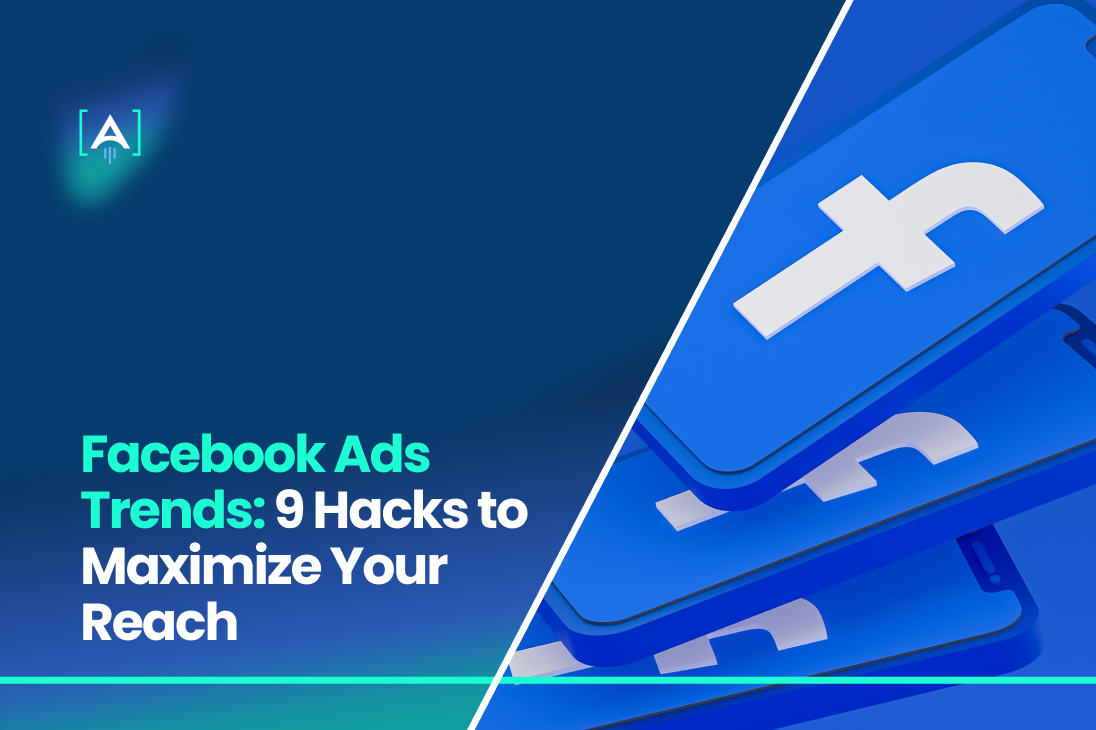Billions of active users are scrolling through their newsfeeds every day.
We should accept Facebook has become the goldmine for almost everything.
And what about businesses that are looking to connect with their target audience?
That is their niche purpose, which is to keep their presence there.
Navigating the complex world of Facebook ads can be awful, even for professional marketers.
Market leader Facebook was the first social network to surpass one billion registered accounts and currently sits at more than three billion monthly active users.
Source: Most popular social networks worldwide as of April 2024, by number of monthly active users, Statista
We could discuss longer what is behind the success of Facebook.
Long story short, 3 essential reasons behind Facebook’s success are:
- Massive, Diverse User Base
With over 3 billion active users, Facebook offers unparalleled access to a wide variety of audiences, making it a prime platform for reaching diverse demographics and interests.
- Advanced Targeting and Personalization Tools
Facebook’s robust data collection enables precise Facebook ads targeting and personalization. Advertisers can leverage targeting options like lookalike audiences, interest-based targeting, and dynamic creative optimization to reach the right audience with relevant content.
- Constant Innovation and Feature Expansion
Facebook continually adapts with new features (e.g., AI chatbots, shoppable posts, short-form videos) to keep up with changing trends and user behavior, ensuring it remains a relevant and engaging platform for both users and businesses.
Accordingly, who can master the reasons mentioned above for Your Business Success? Indeed, a professional Facebook Ads Agency knows how to proceed and contribute to your work.
In this guide, we’ll uncover the secrets of Facebook advertising, from crafting compelling ad creatives to optimizing campaigns for maximum ROI.
1. AI-Powered Targeting: “Know Your Audience Before They Do”
Simply knowing who your customers are is no longer enough.
Predicting what they want, often before they even realize it, has become the true game-changer for businesses using AI-powered targeting.
By harnessing artificial intelligence in Facebook ad strategy, brands can gain deep insights into customer behaviors, allowing them to anticipate needs and craft content that feels remarkably relevant.
AI targeting isn’t just another tool—it’s a way to build more meaningful connections with audiences that drive results.
Why AI-Powered Targeting is Essential for CEOs
For CEOs, understanding how AI can elevate ad relevance is crucial.
Today, Facebook Ads leverage machine learning algorithms to dive deeper than basic demographic data, identifying patterns that help pinpoint not only who might be interested in your product but also when, where, and how they’re most likely to engage with it.
Imagine, as a CEO, being able to see specific audience segments within broad target groups, thanks to AI-powered segmentation.
These niche groups often make up the backbone of high-performing ad campaigns, delivering enhanced engagement, higher click-through rates, and ultimately, a stronger return on investment (ROI).
Personalizing Ads with AI for Higher Engagement
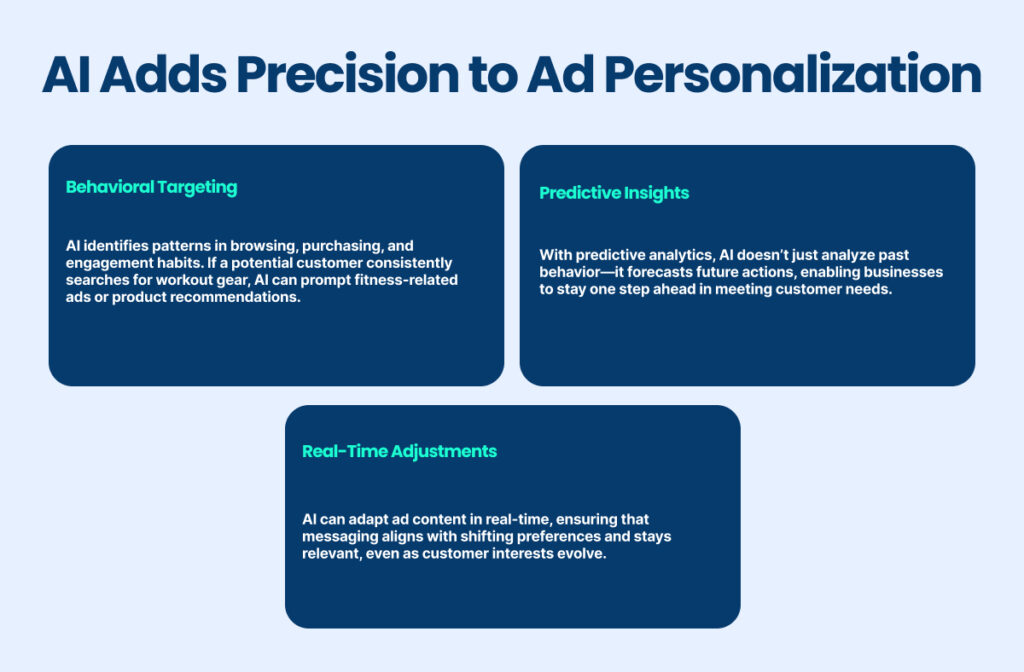
AI-powered targeting turns ordinary ads into personalized experiences.
Consider Facebook video ads, for instance—by using AI insights; brands can create and deliver videos specifically tailored to individual audience segments, right down to the messaging, format, and call-to-action.
It’s personalization at scale, allowing companies to connect with audiences as individuals, fostering a stronger relationship and increasing the likelihood of engagement.
With Facebook’s advancements in AI targeting, this approach has become more accessible than ever. Here’s how AI adds precision to ad personalization:
The “Human Factor” in AI Targeting
AI may be rooted in technology, but its greatest asset is its ability to create more human connections.
Through machine learning, businesses can craft ads that feel intuitively aligned with customer interests.
CEOs and business owners can rest assured knowing that this “human touch” in AI is not an automated impersonation of customer service; it’s a genuine enhancement of the customer experience backed by data.
For instance, Facebook lead ads can now adjust messaging to feel more conversational, addressing customer questions and concerns with warmth and relevance.
This approach results in a seamless experience, reinforcing brand credibility and building trust—an invaluable factor in today’s market where 90% of consumers value authenticity in advertising.
2. The Shift from Static to Dynamic: Welcome to a New Era of Facebook Ads Success
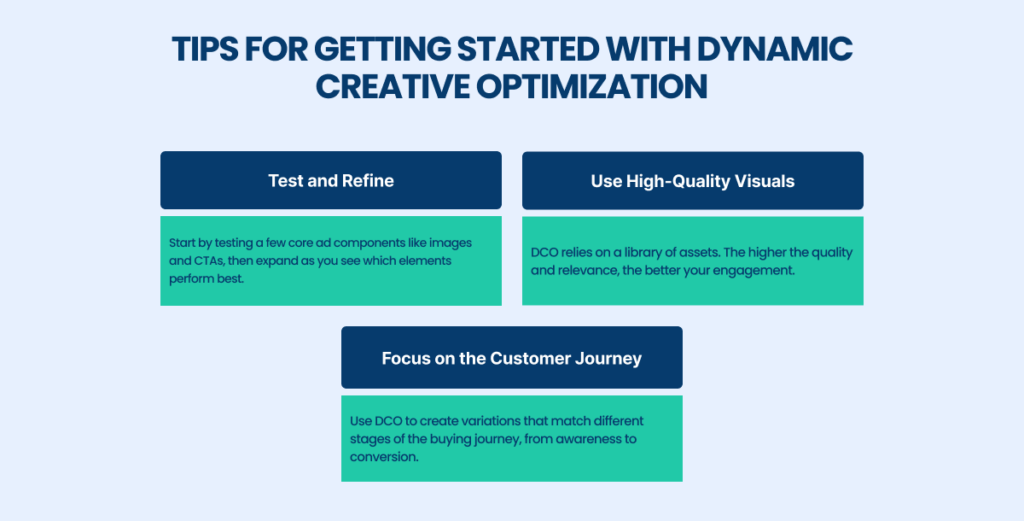
In the fast-evolving world of Facebook ads trends, static ads have started to feel a bit out of touch.
Today’s audiences crave more tailored experiences that resonate with their preferences, and that’s where Dynamic Creative Optimization (DCO) steps in to make a difference. So, what is DCO, and why is it becoming essential for businesses aiming for Facebook ads success?
Source: Sprout Social
Dynamic Creative Optimization is an advertising tool that automates and customizes ads by creating multiple variations based on audience engagement.
Rather than running the same ad for every viewer, DCO uses machine learning to test different elements—images, calls-to-action, and text variations—and delivers the combination that works best for each person.
This means you’re not just serving ads—you’re engaging with your audience on a more personal level.
Why Static Ads No Longer Make the Cut
Static ads were once the standard, but as trends in Facebook ads shift toward personalization, static ads have fallen behind.
- Limited Customization: Static ads use the same elements for every viewer, meaning they don’t adapt to individual preferences or behaviors.
- Lower Engagement: Ads that don’t speak to each viewer’s unique needs struggle to capture attention, which can lead to lower click-through rates (CTR) and fewer conversions.
- Missed Optimization Opportunities: Without real-time adjustments, static ads can’t respond to the learning insights gathered from user interactions.
Simply put, the one-size-fits-all approach of static ads can feel stale and out of touch in today’s digital landscape. For business owners and CEOs aiming for success, embracing a dynamic approach like DCO is key to staying relevant and capturing your audience’s interest.
What DCO Brings to the Table
Dynamic Creative Optimization turns each ad into a powerful tool for engagement by adjusting its elements automatically.
- Personalization at Scale: DCO tailors every ad experience by swapping out images, headlines, or CTAs based on what resonates best with different users.
- Real-Time Adjustments: The system continuously learns from user interactions, adapting and improving over time.
- Better Performance Metrics: With a more tailored approach, DCO can improve key performance indicators (KPIs) like CTR, conversion rates, and overall engagement.
So, what does DCO look like in practice? Imagine an ad that updates its CTA for returning customers versus new visitors or an image that changes to align with a user’s browsing history.
These shifts might seem small, but the data shows that personalization can drive up to 20% higher engagement and an overall boost in ad performance.
How DCO Works: From Ad Variations to Engagement
Dynamic Creative Optimization breaks down each ad into its core components, like images, text, and CTAs, and tests these elements to see which combinations perform best with different audiences.
- Images: DCO can test multiple visuals, swapping out images based on what each user group prefers.
- Text and Headlines: Different text and headline variations are shown to users, helping the system learn which phrases catch attention.
- Call-to-Action (CTA): DCO adjusts CTAs based on user intent; for example, “Learn More” may be shown to first-time visitors, while “Buy Now” may be prioritized for returning customers.
By continuously optimizing these components, DCO refines each ad experience to increase relevance, encouraging deeper engagement with each audience segment.
3. UGC in Facebook Ads: “Turning Customers into Advocates”
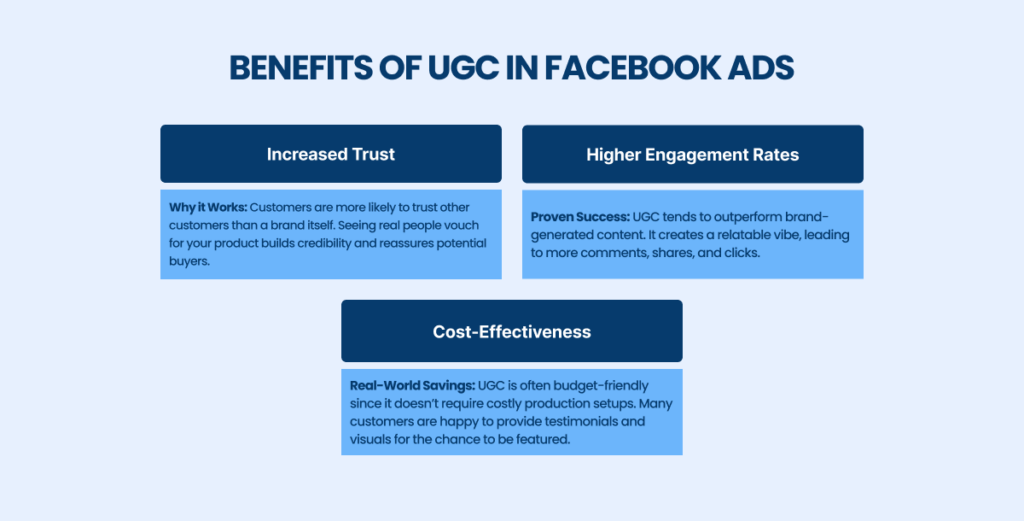
Nothing speaks louder than User-Generated Content (UGC).
For business owners and CEOs aiming to enhance their Facebook ad strategy, integrating UGC into ads can be a game-changer.
Why? Because UGC brings a level of authenticity and trust that traditional advertising struggles to achieve.
In an age of digital information overload, consumers are more likely to believe the voices of fellow customers over highly polished brand messages.
Why UGC Matters: Authenticity That Resonates
Let’s start with the basics: Why is UGC so effective? Unlike highly curated content, UGC comes directly from real users who’ve genuinely engaged with your brand.
These are customers sharing their experiences, which means the content feels genuine rather than a hard sell.
This authenticity translates into higher engagement rates and trust levels, making it one of the most effective trends in Facebook ads today.
How to Incorporate UGC in Your Facebook Ads
Using UGC in Facebook ads is about leveraging your existing customers’ experiences and amplifying them. Here’s a strategic approach for business leaders who want to integrate UGC successfully:
1. Highlight Real Customer Testimonials
User testimonials are gold for brands. They capture real voices and sentiments that can speak directly to prospective buyers. Include quotes from reviews or short snippets that capture positive customer experiences.
- Example: Use a snippet from a five-star review in your Facebook ad copy, like “This product has changed how I work every day!” – Julia R.
- Impact: Authentic testimonials build instant credibility and make new customers feel comfortable about trying your product.
2. Incorporate Visual UGC for Higher Engagement
Nothing captures attention like seeing a real customer using your product.
Visual UGC, such as customer photos or videos, brings a powerful sense of realism to your Facebook ads.
Today, Facebook lookalike audiences can help your ad reach users who closely resemble those engaging with your UGC, expanding the ad’s impact.
- Pro Tip: Ask customers to share images or videos of them using your product, and then feature these in your ads with permission.
3. Feature UGC in Facebook A/B Testing for Optimal Results
If you’re considering different ad formats, Facebook Ads a/b testing can help you understand how UGC compares to traditional content.
Run tests where one ad features polished brand visuals while another uses customer-generated content. This allows you to see which version resonates more with your target audience.
- Tip for CEOs: A/B testing with UGC is a great way to validate the impact of authenticity on your engagement metrics. Don’t be surprised if the UGC version outperforms in terms of click-through rate and conversions.
4. Showcase Customer Stories as Success Narratives
For higher-ticket or service-based products, customer success stories provide a compelling narrative. These stories show how your brand has positively impacted a customer’s life or business.
Use UGC to tell these stories visually and in the ad copy, highlighting specific benefits your audience can relate to.
- Example: An accounting software company might showcase a video from a small business owner discussing how the tool saved them time and improved accuracy.
- Why it Works: Success stories are not only inspiring but also informative, positioning your product as a valuable solution to specific pain points.
4. Micro-Influencer Partnerships: “The Power of Influence—Without the Celebrity Price Tag”
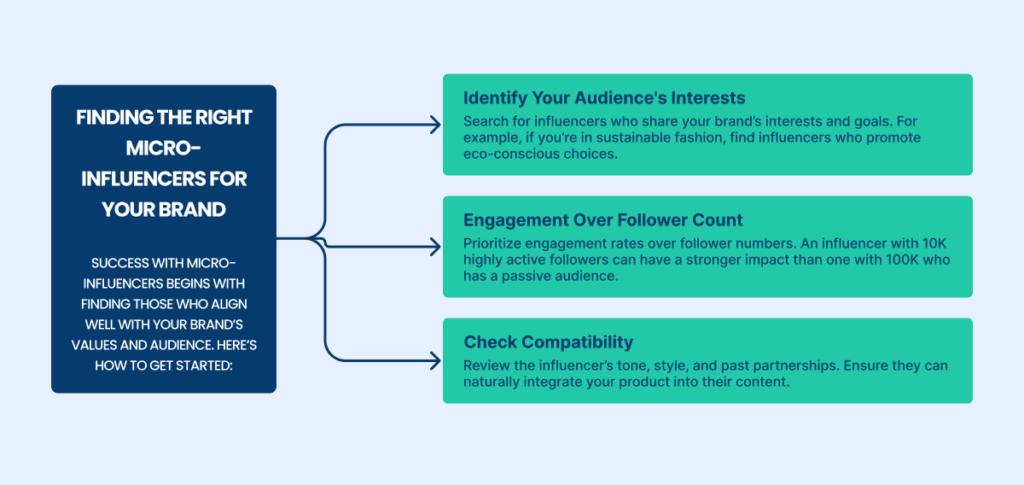
In the world of social media, micro-influencers are rewriting the rules.
Unlike celebrity influencers with millions of followers, micro-influencers have smaller, highly engaged audiences. This can make them more cost-effective and often more authentic than their high-profile counterparts.
For CEOs, this shift in Facebook ads trends represents a valuable opportunity to leverage influence at a fraction of the cost.
The Appeal of Niche Influencers for Cost-Effective Reach
Micro-influencers may lack celebrity status, but they make up for it with credibility. Their followers trust them, which can lead to much higher engagement rates—often up to 60% more than with larger influencers.
Why does this matter? For CEOs and business owners, micro-influencers offer a targeted and relatable voice that speaks directly to niche audiences, making your brand more accessible.
- Targeted Authenticity: Micro-influencers typically focus on niche interests (e.g., eco-friendly products, tech gadgets, fitness). Their followers feel connected to these influencers and trust their recommendations, which makes your brand message resonate better.
- Higher Engagement, Lower Cost: Compared to macro-influencers, micro-influencers are budget-friendly, and their audiences are often more engaged. If you’re aiming for Facebook ads success without overspending, micro-influencers are a perfect choice.
How to Measure Success with Chatbots in Facebook Ads
Once your chatbot is up and running, measuring its impact is essential. Metrics will give you insights into its effectiveness in nurturing leads and driving conversions:
- Response and Engagement Rate: How often are users interacting with the chatbot? High engagement indicates that the bot is offering valuable assistance.
- Conversion Rate: Track how many chatbot interactions result in completed sales or sign-ups. This helps gauge its success in converting interest into revenue.
- Average Response Time: Bots should respond instantly, so if there’s a delay, you may need to fine-tune the system.
For CEOs looking to maximize Facebook ads success, a well-optimized chatbot can be a low-cost, high-impact addition to their Facebook marketing strategies.
5. Short-Form Video Content: “Bite-Sized Stories That Convert”
In today’s digital landscape, capturing attention quickly is everything.
Short-form video content—think TikTok, Instagram Reels, and Facebook Stories—has exploded in popularity, and it’s not hard to see why.
These bite-sized videos are highly engaging and can effectively convey your message in seconds, making them a perfect addition to Facebook advertising strategies.
Leveraging Quick, Engaging Videos for High Impact
Short-form videos pack a punch because they communicate your message in an easily digestible format.
For CEOs, this means that these videos are powerful tools for making an impression without overwhelming viewers. Here’s why these videos are so effective in Facebook campaigns:
- Instant Engagement: A quick, catchy video immediately captures attention in a crowded feed. In a study by Facebook, 60% of viewers were more likely to buy a product after watching a short video ad.
- Versatile Formats: Short videos are adaptable, working well across Facebook Stories, Reels, and News Feed ads. This flexibility ensures that you reach different types of audiences across Facebook’s ecosystem.
- Easy A/B Testing: With short-form content, you can quickly experiment with various messages, visuals, and calls-to-action to find what works best. Facebook ads A/B testing with short videos provide insights without exhausting your budget.
Crafting Short-Form Content That Drives Conversions
To make these quick videos as effective as possible, focus on strong storytelling and clear calls-to-action. Here are a few tips for creating high-impact, short-form video content:
- Start with a Hook: The first few seconds are crucial. Use eye-catching visuals or an intriguing question to keep viewers engaged.
- Keep It Focused: In 15-30 seconds, there’s no room for fluff. Focus on a single, compelling message—whether that’s highlighting a feature or promoting a limited-time offer.
- Include a Call-to-Action: Encourage viewers to act immediately. This could be a “Shop Now” button, a swipe-up link, or a short URL.
For business owners and CEOs, short-form videos offer a unique, cost-effective way to connect with audiences quickly and effectively.
They are an ideal solution for engaging customers who may not have time for lengthy ads but are ready to engage if the content resonates.
6. Value-Based Lookalike Audiences: “Targeting Customers Who Act Like Your Best Ones”
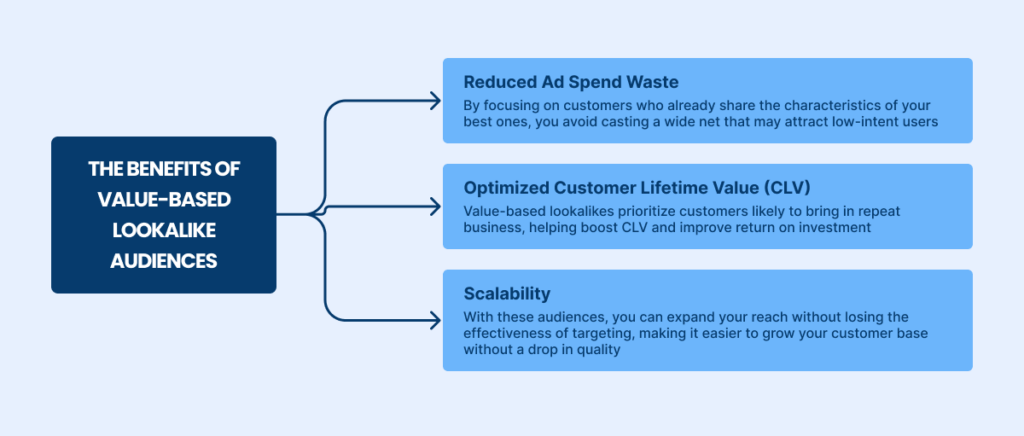
If you’ve been searching for a way to expand your reach with precision, value-based lookalike audiences are your answer.
By tapping into data from your best customers, value-based lookalike audiences allow you to attract new audiences who share similar traits, spending patterns, and behaviors.
How to Set Up Value-Based Lookalike Audiences Using Meta Pixel and Data Sources
Getting started with value-based lookalikes on Facebook is straightforward with the help of Meta Pixel, Meta’s advanced tracking tool. Here’s how you can set it up for optimized targeting:
- Install Meta Pixel: First, add the Meta Pixel to your website to track customer actions. This is a quick way to gather insights on who visits your site, engages with content, and completes purchases.
- Define High-Value Data Sources: Set up your Pixel to capture valuable actions that signal high intent, like “Add to Cart,” “Purchase,” or “Repeat Purchases.”
Meta Pixel can recognize these data points and organize them into a “seed audience” that reflects the profile of your top customers.
- Create Your Lookalike Audience: In Facebook Ads Manager, select your high-value customers as the source for your new lookalike audience.
You can refine it by country and choose the “value-based” option. Facebook will then pull characteristics from your best customers to find others who match their profile.
- Adjust the Size for Focused Targeting: Lookalike audiences range from 1% to 10% of the target country’s population, with smaller percentages reflecting closer matches to your core customer base.
Starting small (e.g., 1% to 3%) ensures you’re reaching people most similar to your current high-value customers.
7. Broad Targeting Strategy: “Let Facebook’s Algorithm Find Your Best Customers”
While it’s tempting to get granular with targeting from the start, broad targeting can work wonders for your ad campaigns.
By setting broader parameters, you allow Facebook’s algorithm the freedom to explore a larger pool of users, gather valuable insights, and eventually narrow down to those most likely to convert.
Why Start Broad?
Facebook’s advertising algorithm has advanced significantly, meaning it can now make smarter decisions about who to show your ads to based on real-time data.
When you start broad, you’re essentially giving Facebook room to experiment, analyze user interactions, and ultimately help you reach a more refined audience.
- The Key Advantage: Broad targeting provides a wealth of data. By initially casting a wider net, you’re equipping the algorithm to “learn” what works, allowing it to identify user trends, preferences, and engagement patterns.
- Stat Spotlight: Campaigns using broad targeting have seen up to a 30% increase in ad performance once the algorithm has had time to gather data and optimize.
How Broad Targeting Works with Facebook’s Algorithm
Broad targeting involves setting fewer constraints on your audience demographics or interests, allowing the Facebook algorithm to assess user responses across a wider range.
As the campaign progresses, the algorithm collects data on which users engage with the ad, slowly refining its target audience.
- Begin with Minimal Filters: Skip hyper-focused criteria, such as specific interests or behaviors, and let the algorithm find out who interacts with your ad. Broad categories like location, age range, or gender can be helpful without being restrictive.
- Use Conversion Data to Train the Algorithm: If you’ve installed Meta Pixel, Facebook can track conversions and begin associating similar behaviors among your audience. The algorithm will quickly pick up on patterns, targeting users who show signs of interest or intent.
- Monitor and Adjust Budget as Needed: Start with a budget that gives the algorithm room to experiment, but watch for any early signs of high or low performance. Allowing flexibility with the budget enables the algorithm to reach more users and collect more data.
- Leverage “Event Signals”: Every interaction counts as an “event” to Facebook’s algorithm, from clicks and likes to shares and comments. Broad targeting encourages more diverse engagements, which provide deeper insights for the algorithm.
8. Conversion Tracking and Analysis: “Why Every Click Counts”
Every click, scroll, and interaction plays a crucial role in painting a clear picture of your campaign’s success.
For CEOs and business owners, understanding how each action affects the bottom line means leveraging the right metrics and tracking tools to make data-driven decisions that enhance ROI.
Why Conversion Tracking Matters in Today’s Facebook Ad Landscape
Facebook ad strategies have become increasingly sophisticated. With rising competition, understanding which ads drive conversions—and why—is essential for optimizing budgets and achieving goals.
Conversion tracking lets you see the real impact of your ads, enabling you to tweak and scale campaigns for optimal results.
As trends in Facebook ads continue to shift toward data-driven personalization, conversion tracking, and analysis provide insights that are invaluable for maximizing ad effectiveness.
Using Meta Pixel and Conversions API for Enhanced Tracking
Facebook provides two powerful tools—Meta Pixel and Conversions API—that allow you to track conversion events accurately and gain deep insights into user behaviors.
These tools provide a comprehensive view of ad impact, helping CEOs and business owners make informed decisions on where to allocate resources for the greatest ROI.
Meta Pixel: Meta Pixel is a piece of code you place on your website to track visitor actions, such as clicks, purchases, or sign-ups. It records and reports events back to Facebook, providing valuable data on ad performance.
How It Works: When users interact with your ad, Meta Pixel tracks each action, allowing you to measure conversions across devices. For example, if a user clicks an ad on mobile but completes a purchase on desktop, Meta Pixel will capture both steps in the journey.
Conversions API: This tool works alongside Meta Pixel to track conversions directly from your servers, making it ideal for businesses with advanced data tracking needs. Conversions API captures data that might otherwise be missed due to browser restrictions or ad blockers.
How It Works: By sending conversion data directly to Facebook’s servers, the Conversions API provides a more complete view of the customer journey, capturing actions that happen outside your website (like in-app events).
The End: Mastering Trends for Maximum Reach and Engagement
If you have reached this point, it means you have read everything in much detail.
Now, it’s time to take action. Start by analyzing your current Facebook advertising strategy. Are you leveraging the latest trends and best practices? Are your ads visually appealing and compelling? Are you targeting the right audience?
[A] Growth Agency will keep you informed. Our team knows the deep essence of Facebook and its strategies.
Excellence is our standard. We cultivate a team of ‘A players’ – top-tier talents who bring passion and expertise to every challenge.
Ready to elevate your Facebook advertising game?
You make the choice; we guide you through the challenges.
